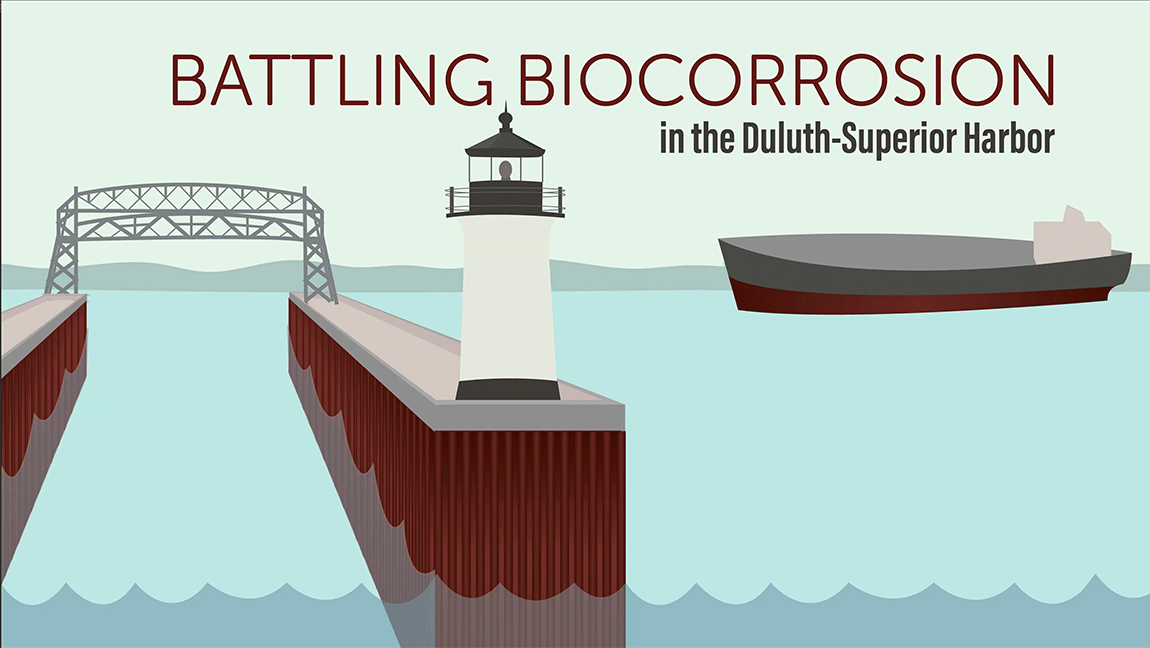
Scientist Mikael Elias, pictured above, was the recipient of the 2017 Early Innovator Award from the University of Minnesota.
The goal of this research project is to develop an enzyme-based coating for freshwater harbor infrastructure that resists corrosion. The researchers leading this project expect to improve their previous coatings to reduce biofouling more effectively and with far fewer environmental consequences than other methods.
Project description
Biofouling, the accumulation and attachment of things such as mussels, limpets and algae to underwater surfaces, is the bane of shipping and other industries tied to the Great Lakes and oceans.
Since 2012, the researchers funded for this project have worked to identify a substance that would prevent or slow the attachment of unwanted organisms. They isolated a new family of enzymes that hijack bacterial communication in a way that prevents films of microorganisms from forming. Without a film of microorganisms, species like zebra mussels are far less likely to attach to surfaces.
A promising ingredient for antifouling coatings is one enzyme in particular, SsoPox, which is derived from a single-celled species collected on the Vesuvius volcano. Proof-of-concept experiments by the researchers suggest that a genetically engineered variant of SsoPox is capable of preventing biofouling in seawater and can reduce freshwater corrosion rates associated with films of bacteria by 50% after two months. Antifouling coatings using this enzyme are also 1,000 times less toxic than the popular copper-based coatings, which are under environmental scrutiny worldwide.
The researchers are conducting longer-term tests of enzyme-based coatings in the Port of Duluth-Superior harbor. The researchers expect to improve the coatings by optimizing enzyme activity, stability, durability and release. By 2020, the researchers expect to relate changes in biofouling rates associated with the enzyme-based coating to changes in the composition of bacterial communities. This new coating technology could reduce biofouling more effectively and with far fewer environmental consequences than other methods.
The University of Minnesota’s MnDrive Initiative is supporting complementary work “Battling Biocorrosion” to investigate the enzyme’s effectiveness against biocorrosion and biofouling by plants and animals.
Funding
Minnesota Sea Grant provided research support through our 2018-2020 biennial competitive Request for Proposal (RFP) process.
Lead scientist(s)
Mikael Elias
Associate Professor
Biochemistry, Molecular Biology, and Biophysics
College of Biological Sciences
University of Minnesota
mhelias@umn.edu
Scholarly Articles
Huang S, Bergonzi C, Smith S, Hicks RE, Elias MH. 2023. Field testing of an enzymatic quorum quencher coating additive to reduce biocorrosion of steel. Microbiol Spectr11:e05178-22.https://doi.org/10.1128/spectrum.05178-22
Bergonzi, C., Schwab, M., Naik, T., & Elias, M. (2019). The structural determinants accounting for the broad substrate specificity of the quorum quenching lactonase GcL. ChemBioChem. https://doi.org/10.1002/cbic.201900024
Partners
- AMI Consulting Engineers, Industry and Business
- Duluth Seaway Port Authority, Industry and Business
